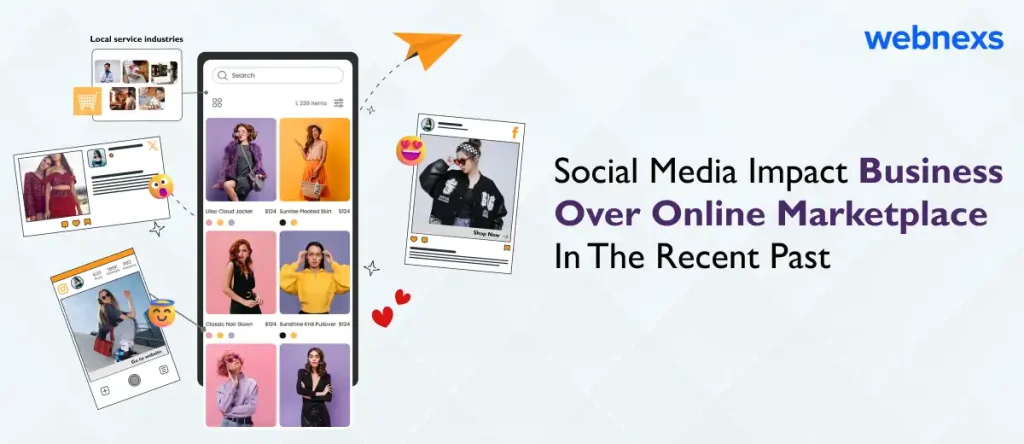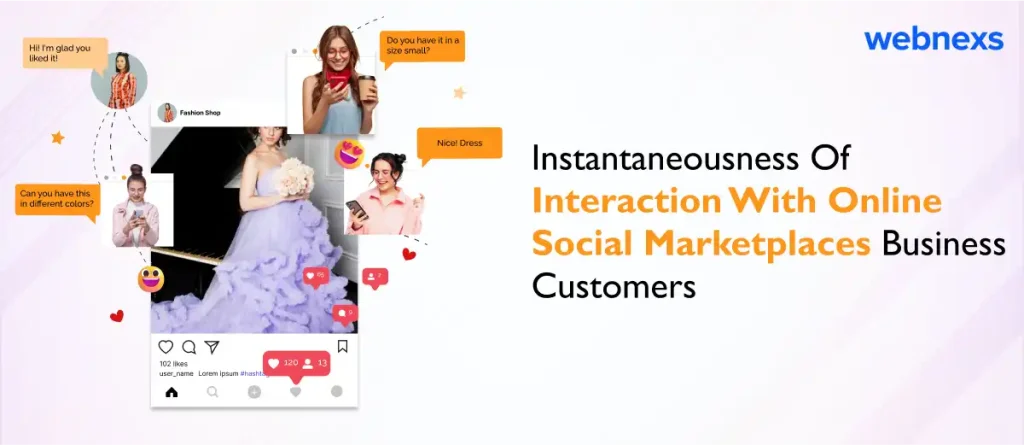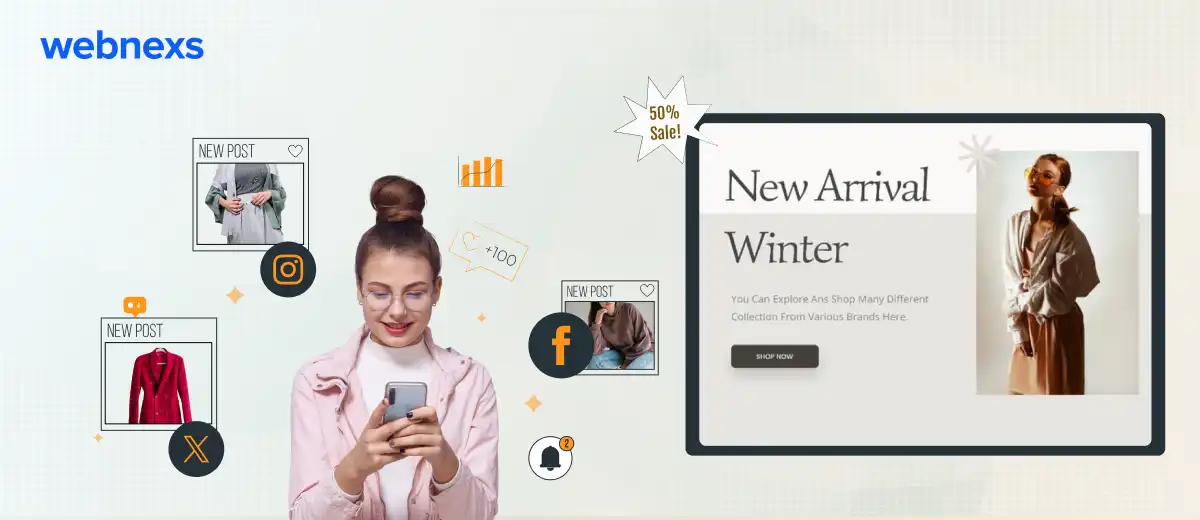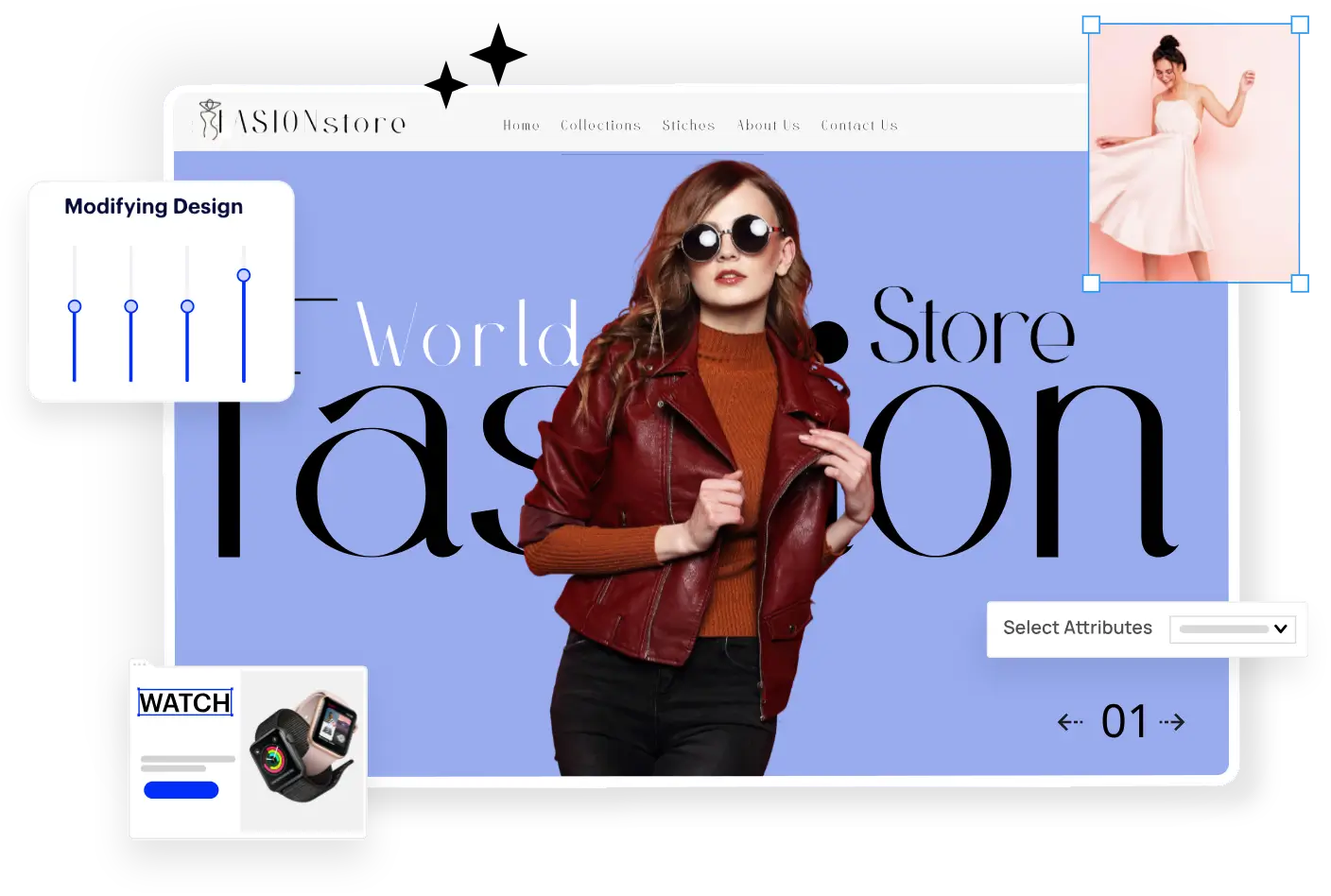In today’s digital world, the influence of social media marketplace on online businesses cannot be overstated.
With millions of users engaging on social media marketplace platforms like Facebook, Instagram, and X businesses have unprecedented opportunities to connect with their target audience.
From boosting brand awareness to driving website traffic and increasing sales, social media has become a vital tool for businesses of all sizes.
In this article, we’ll explore the how does social media impact business and how online marketplaces can leverage these platforms to thrive in the competitive digital market.
Nowadays, social media marketplaces greatly impacts online businesses.
When there are many browsers to choose from back in the days of chat rooms, there are many browsers during Internet inception. The time we mention is when no one could imagine the arrival of marketplace social media in day-to-day activity.
It controls communication-related activities, but today it has changed the way we browse, the way we shop, and our social behaviors. It made a drastic impact and altered the way companies market their products and services online.
Have a look at the fascinating stats of social media impact business, the online marketplace on the day-to-day run:
- Social media helps about 84% of online shoppers to find and make a shopping decision.
- Today, 2 in 5 business owners are selling through Facebook.
- 46% of merchants see social media as a great tool to generate sales online.
- 62% of online shoppers buy directly from the social media platforms.
- 73% of eCommerce marketers believe social media marketing is the most effective method to market their products.
Grow Your Online Business With Social Media Marketplace!
Social Media Marketplace Impact Online Business In The Recent Past

Highly Targeted Advertising Via Social Media Marketplaces
Social media platforms allow businesses to reach specific demographics in defined locations. Over 80% of marketers report increased exposure through social media marketing.
Have you remembered the days many businesses solely rely on billboards, magazine ads, long-range radio jingles, and popular television commercials to advertise their products and services?
Those acts helped their intent of luring the larger audience, which would see one form of advertisement and be active and move to make a purchase.
See today, Facebook and Instagram advertising allows businesses to land in a particular demographic within a confined radius. They would pick the specific radius from where the company is present to make easy business flow.
Local service industries such as doctors, painters, dentists, real estate agents, restaurants use this highly-targeted advertising to pull the audience to their relevant marketplace website and put their niche services in front of the intended users in a few seconds.
Build and market your ecommerce marketplace today with Headless Ecommerce Solution!
Instantaneousness Of Interaction With Online Social Marketplaces Business Customers

Around 74% of users prefer messaging businesses directly on platforms like Facebook Messenger, and 62% of millennials are more loyal to brands that engage them on social media.
We say social media is the best and worst thing that has made online shoppers’ attention span even shorter.
Before the inception of the internet, if a customer had a bad experience with a store, product, or service, they would write a letter via postal service. It made them wait for four to six weeks for a proper response.
Later the response time got lower when people started to use email widely. It significantly reduced the interaction and response time to one business day; at most, it’s excellent at that time.
Now even the response time shortened to a few minutes with social media marketplace exposure.
A recent study says that about 74% of social media users expect the admin or staff to respond to their queries or concerns inscribed in less than an hour.
Hence, the expected immediacy of social media interaction with the brands people use has hurt many businesses as they have tried keeping up with social media.
So, they do it will all the expense of actually running their business.
Read More: Build an Ecommerce Marketplace Website like Amazon in 8 Simple Steps
Rebound Is Real In Online Business Marketplace Social Media
Negative reviews or poor interactions on social media can harm a brand’s reputation, but 71% of consumers are more likely to recommend a brand after a positive interaction.
While social media enjoy generous support and significant advantages on the ecommerce marketplace, one small false move can impact your presence on any platform.
Even it may come from your angry employee, a bad review and nasty rumors can have an adverse effect. It affects not only the online presence of your marketplace business but also the bottom line.
Every interaction on social media has an impact on online business represents the company’s brand across the channels.
The entire process of maintaining the business’s social presence and the image is not easy in the current scenario but necessary.
While it may seem more straightforward to avoid social media altogether in your online marketplace business, be in the current trend and boost your brand visibility and awareness from the bottom line with a proper social media eCommerce marketing campaign.
The statistical number conveys immense potential in leveraging social media platforms. Begin the journey with Webnexs white label solution and capitalize on to materialize your online store.
Grow Your Online Business With Social Media Marketplace!
What are the ways in which social media impacts online marketplaces?
1. Increases visibility
The concept of a social media marketplace has been adopted by online businesses seeking visibility and connection with their target audience.
Popular platforms like Instagram, Facebook, and TikTok hold millions of users’ accounts which are being used by the ecommerce platforms.
To quote some real-time figures, Instagram, with over 2 billion monthly active users, has 90% of its users following at least one business.
Likewise, Facebook is predicted to reach 80 million shoppers by 2025. This makes it an unbeatable option for ecommerce platforms.
To utilize this opportunity, boosted posts, targeted ads and collaborations help increase discoverability to draw traffic and widen exposure through the best social media sites available.
2. Customer engagement
It is a reactionary method that is elicited from steps taken to reach the target audience with the intention to create and foster a rapport with the business that is ongoing.
Through comments, direct messages, and live streams, real-time interactions take place to create a sense of urgency to take action and trust to ensure repeat purchases.
For instance, a study has found that 78% of customers are ready to engage with brands on social media.
This clearly shows the potential to further optimize the social media advertising strategies to increase conversion rates across other social media platforms.
An apt example of this would be TikTok Shop, which was able to achieve $100 million in sales during Black Friday, owing this to the interactive features that were able to drive engagement and sales.
3. Driving traffic and sales
Over the years, the opportunities and potential to grow ecommerce platforms have increased drastically as social media platforms are evolving by integrating features that directly support online sales or at least a basic call to action that could lead to a conversion in the future.
Examples include Shoppable Posts, Product Tags in Videos, and Stories with Swipe-Up Links, to name a few, and the list continues.
Moreover, referral traffic is also becoming a trend where Pinterest 89% of the users gain purchase inspiration.
This has paved the way for the rise of the social media marketplace, where the skyrocketing number of consumers making purchases directly through social media has strengthened the integration of online marketplaces with social media platforms.
4. Social proof
Social media is an open forum to share reviews and video testimonials, which becomes a word-of-mouth marketing that creates awareness to other users as well.
A study has found that 72% of customers after reading reviews have developed enough trust to make spontaneous purchases.
To complement these, likes, comments and the number of shares further build confidence by establishing a firm endorsement.
This validation is one of the key benefits of social media marketing and is essential to the overall marketing strategy.
5. Community building
With the digital space, there are truly no limitations to the extent of efforts that can be taken to reach the target audience.
This is being proved by creating niche communities around products or services, and these forums are being used to discuss and send product updates that build a long-term rapport.
An unbeatable example would be MacRumors, a dedicated website that features a complete guide on how-tos, reviews, product updates and everything Apple.
These help strengthen the brand-consumer relationship, similar to how social media marketplaces foster engagement and loyalty.
6. Market research and insights
Data is everything, without data there is no sales. Social media platforms inherently provide tools such as Instagram Analytics and Facebook Insights.
These provide data on various metrics from engagement to performance.
The right exposure to the right target audience can be achieved when accurate data enables you to shape your strategies effectively to uncover wider opportunities in the online space.
Furthermore, trend analysis renders information to determine demand and frame suitable approaches to serve the needs of the market, showcasing the power of marketing through social media.
7. Cost-effective marketing
Compared to traditional advertising, social media ads are very cost-efficient, as they are a combination of organic and inorganic marketing channels.
The huge costs associated with the need for infrastructure to publish display boards, as a typical example, are eliminated.
It is a highly affordable option, especially when there are multiple platforms available to advertise.
This promise is further backed up by data that mentions the social media ad market is expected to grow annually by 26.2% until 2030, highlighting its significant role in generating leads and conversions in the social media marketplace.
8. Influencer collaborations
Partnering with influencers who have gained a considerable amount of followers online is another source to reach the desired target audience.
By doing so, you can tap into the followers of the influencers. This is an efficient way to gain exposure where trust is also created that has a likelihood of spontaneous purchases.
They have been able to drive sales to a notable level. To cite an example, we can go back to 2023 when 20% of the revenue had been generated by collaborations with influencers on Cyber Monday.
The numbers make it clear that online social media marketing through collaborations can significantly boost sales.
9. Cross-promotion opportunities
Brands help promote each other creating a win-win situation.
Instagram offers features to collaborate and share posts on accounts together to facilitate these cross-promotional activities.
Fenty and Sephora are ideal examples, both cross-promote each other to gain visibility and increase sales.
Alongside this, live streaming as a feature is projected to add 20% of worldwide ecommerce sales by 2025 through cross-promotion.
Since it is an interactive session, the likelihood of conversions is higher, making it a powerful tool in social media marketing ads.
10. Customer support
Nowadays, where there is widespread information on product how-tos and troubleshooting assistance online, customers are becoming less dependent on support over the phone.
Social media is being increasingly used to provide support by offering tutorials and rendering personalized responses.
This quickness enhances customer satisfaction. A study reveals that 71% of consumers receiving convincing social media service are likely to share a positive word-of-mouth to others.
This highlights the benefits of social media as an intermediary for connecting brands and consumers.
11. SEO
The search engines are optimized to indirectly improve SEO when brands are active on social media.
Active engagement refers to posting regularly on social media and the results are encouraging, with almost all the brands actively engaging.
It is noted that 31% more referral traffic is generated compared to brands that don’t actively participate in posting regularly.
Needless to say, it is made possible by increasing visibility and referral traffic.
This works by generating backlinks by sharing content with the links to the marketplace which the search engines value for rankings, especially through ads on social media, boosting social media marketing for ecommerce.
12. Retargeting ads
It is a way to reconnect with the potential customer to remind them to take action to convert to actual sales. Previously viewed products, products added to carts and wishlists are targeted.
Studies have found that a 76% likelihood of achieving a conversion is possible by using this strategy.
When compared to targeting new customers, the likelihood of conversions is higher and efforts are also directed efficiently.
This way of nudging serves to be very useful to customers requiring a reminder in their busy schedule, making it effective across different social media platforms.
Now that you are aware of the opportunities to grow your online store, schedule a demo with our experts to translate your vision into a successful ecommerce platform.
How Facebook and Instagram Social Media Marketplaces Drive Online Sales
Now let’s look at two popular social media markteplace platforms and their features designed for driving sales in detail.
Facebook and Instagram have been chosen, which have 3 billion and 2 billion monthly active users respectively.
They have been deeply ingrained into the routine lifestyle of people and have become a part of our everyday lives.
Examining this will help us uncover the ways we can leverage social media marketplace platforms and determine their effectiveness in having a huge impact on the sales of online marketplaces.
- Instagram Shop: Shopping tab on apps to showcase products that enables browsing, saving, and purchasing products directly from the app.
- Shoppable Posts: Clickable product tags can be added to posts that link to the product page directly.
- Shoppable Stories: Swipe-up or stickers in Stories direct to particular product pages. Stickers can be products to display in Stories.
- Live Shopping: Products can be showcased with clickable links while live streaming for immediate purchase.
- Product Stickers in Reels: This short-form video content can carry tags to link directly to product pages.
- Product Catalog Integration: Product catalog can be linked with instagram to add them to Posts, Stories and Shops.
- Instagram Ads: Ads can take the form of photos, videos, carousel, stories and explore ads to direct users to the product pages.
- Collections: Products can be organized based on themes, occasions and trends in the Instagram Shop
- Influencer Marketing: Paid partnership as a feature allows influencers to promote products with direct links.
- Saved Product Feature: Products can be collected by saving them for future purchase. These can be viewed later.
- Facebook Shops: Products can be showcased on a customizable storefront directly on their Facebook page. Additionally, it is also integrated with Instagram Shops for cross-platform selling.
- Marketplace: Products can be listed where buyers can view and purchase on demand.
- Facebook Live Shopping: Products can be displayed with clickable links to product pages during live streaming for quick purchase.
- Product Tags in Posts: Product tags with clickable links can be added to posts, directing users to the product page.
- Dynamic Ads: A personalized targeting approach that automatically promotes products based on user behaviour. It is ideal for retargeting.
- Carousel Ads: Multiple products can be displayed in a single ad, each with its own link.
- Collection Ads: Users can browse products directly from the ad with a full screen.
- Facebook Stories with Product Links: Clickable product links can be added to stories that direct users to product pages.
- Group Selling: Products can be promoted in Facebook Groups to enable community-driven sales.
- Facebook Messenger: It assists with product inquiries and purchases with automated FAQs and product page redirects.
- Retargeting: Retarget customers with a previous history of engagement with your sales touchpoints using Facebook Ads.
- Product Reviews and Ratings: Reviews and ratings on product pages can be shared to boost credibility and foster reliability.
Wrapping Up On How Social Media Impact Business
If the information above with respect to social media impact on online business marketplaces is valuable in your point, try using it to benefit in building trust and loyalty with all your customers.
Are you struggling to have reached with your social media channels?
Get your eCommerce marketing techniques and consultation for free today.




